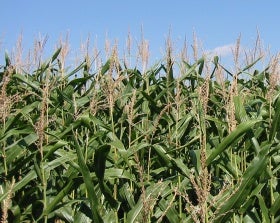Corn Ethanol: Importance of Performance Standards
 This post is by Robert Bonnie, Co-Director of the Land, Water and Wildlife Program at Environmental Defense Fund.
This post is by Robert Bonnie, Co-Director of the Land, Water and Wildlife Program at Environmental Defense Fund.
 The New York Times recently reported that thousands of farmers are dropping out of the federal government’s Conservation Reserve Program. The prices for corn and other crops are so high that conservation subsidies can’t compete with what farmers can make by planting the land. One reason for the high prices is the ethanol mandate in the energy bill Congress passed last year.
The New York Times recently reported that thousands of farmers are dropping out of the federal government’s Conservation Reserve Program. The prices for corn and other crops are so high that conservation subsidies can’t compete with what farmers can make by planting the land. One reason for the high prices is the ethanol mandate in the energy bill Congress passed last year.
Shifts in land use from diverting food-producing land to grow crops for energy – called "indirect land-use change" – can potentially negate the environmental benefits of corn ethanol. There is still much debate on how to measure it, but no question it’s important to consider. One recent study published in Science (Searchinger et. al.) found that using croplands for biofuels causes a significant increase in greenhouse gas emissions relative to gasoline when indirect land use change is taken into account.
Unintended consequences such as these highlight the danger of mandating a specific clean energy technology, and the importance of relying on performance standards instead.
What is "Indirect Land Use Change"?
When food-producing land is diverted for energy production, the food that would have been grown on that land must be grown elsewhere. This prompts farmers to convert land not currently in production into cropland. When grassland or forestland is cleared to grow crops, the carbon sequestered in the soil and trees is released into the atmosphere.
If a lot of new land is cultivated, the resulting carbon release can completely negate the benefits of using biofuels. The New York Times said as many acres as in Rhode Island and Delaware combined were removed from the Conservation Reserve Program, and that’s just one corner of the country. Not all the land was removed due to U.S. biofuel policy, but it plays a part. Some research has found that U.S. policies can contribute to deforestation in southeast Asia and the Amazon.
Assessing the impact of indirect land-use change is tricky, and experts disagree on how to quantify it. According to the Searchinger study, when indirect land-use change is factored in:
- Corn ethanol nearly doubles greenhouse gas emissions relative to gasoline when considered over a period of 30 years, and emissions remain elevated for 167 years.
- Even biofuels from switchgrass, if grown on U.S. corn lands, increase emissions relative to gasoline by 50 percent.
We can’t say whether these numbers are exactly correct, but we can say that indirect land use effects – particularly tropical deforestation – are important to consider.
Shaping Policy to Reduce Emissions
Government mandates for a specific technology to lower greenhouse gas emissions risk unintended consequences – even higher net emissions.
An effective policy that ensures lower emissions has two key components:
A market-based system that rewards less carbon-intensive technologies and land-use practices, whatever they may be.
The Searchinger study suggests that a possible solution to the corn ethanol problem is to use waste products as a "feedstock" (raw material to produce biofuels). Unlike cultivated crops, waste products don’t compete for agricultural land and drive up commodity prices. Sustainably produced cellulosic ethanol made from grasses and wood also may be a viable alternative. Another possibility we’ll discuss in an upcoming post is using algae to make ethanol. But a policy that specifically mandates corn ethanol doesn’t encourage exploration of these other options.
Performance standards based on full lifecycle analysis, including emissions from tropical deforestation and other indirect land use changes.
There is some recognition of this in current policy, but also an important gap. The California Air Resources Board (CARB) Low-Carbon Fuel Standard and Environmental Protection Agency (EPA) Renewable Fuel Standard (RFS) both require consideration of indirect land use in assessing emissions. But the EPA’s RFS exempts corn ethanol from existing facilities from having to meet lifecycle emissions standards.
Biofuels may have a role in our energy future, but only if they’re produced in ways that lower emissions. Performance-based standards and market incentives can prevent the unintended consequences of mandating the wrong technology.













One Comment
Robert,
These are few of my concerns. Minimal corn crop rotation, nutrient depletion, increased fertilization, fertilizers being produced by methane, nutrient loading on vegetation near corn fields, hypoxia in lakes, fish kills…
Dan